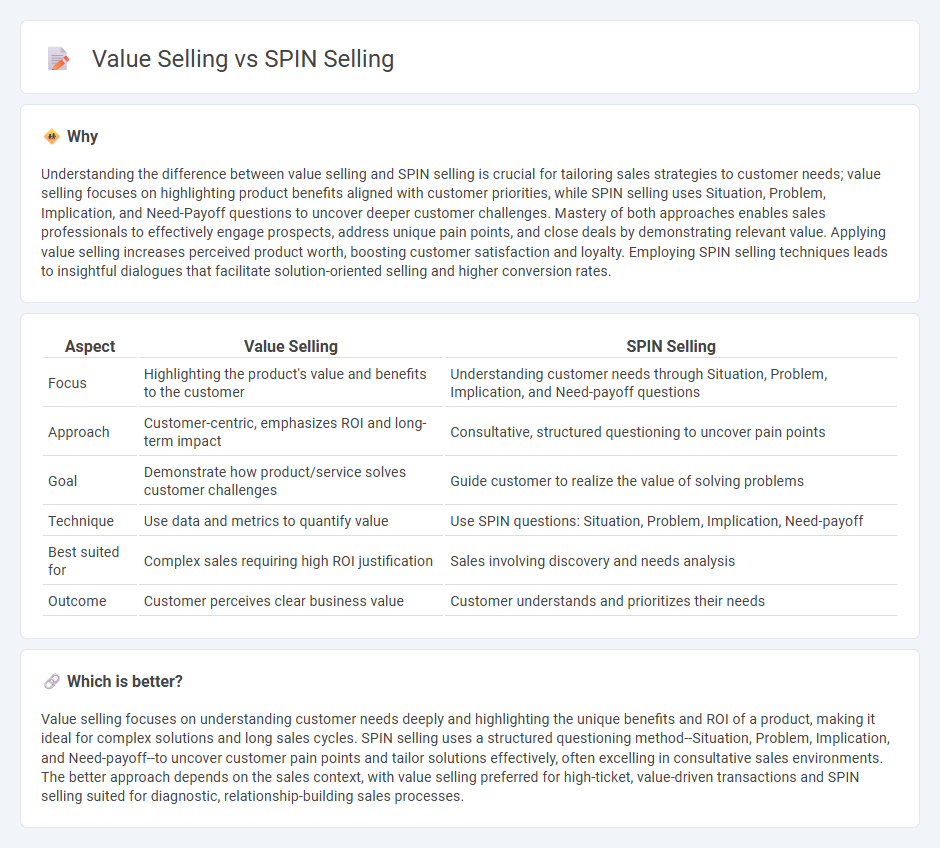
Value selling emphasizes understanding customer needs to demonstrate how a product's benefits align with their business goals, focusing on delivering measurable ROI. SPIN selling uses a structured questioning technique--Situation, Problem, Implication, Need-Payoff--to uncover buyer challenges and tailor solutions effectively. Explore how mastering both approaches can enhance your sales strategy and close deals more efficiently.
Why it is important
Understanding the difference between value selling and SPIN selling is crucial for tailoring sales strategies to customer needs; value selling focuses on highlighting product benefits aligned with customer priorities, while SPIN selling uses Situation, Problem, Implication, and Need-Payoff questions to uncover deeper customer challenges. Mastery of both approaches enables sales professionals to effectively engage prospects, address unique pain points, and close deals by demonstrating relevant value. Applying value selling increases perceived product worth, boosting customer satisfaction and loyalty. Employing SPIN selling techniques leads to insightful dialogues that facilitate solution-oriented selling and higher conversion rates.
Comparison Table
| Aspect | Value Selling | SPIN Selling |
|---|---|---|
| Focus | Highlighting the product's value and benefits to the customer | Understanding customer needs through Situation, Problem, Implication, and Need-payoff questions |
| Approach | Customer-centric, emphasizes ROI and long-term impact | Consultative, structured questioning to uncover pain points |
| Goal | Demonstrate how product/service solves customer challenges | Guide customer to realize the value of solving problems |
| Technique | Use data and metrics to quantify value | Use SPIN questions: Situation, Problem, Implication, Need-payoff |
| Best suited for | Complex sales requiring high ROI justification | Sales involving discovery and needs analysis |
| Outcome | Customer perceives clear business value | Customer understands and prioritizes their needs |
Which is better?
Value selling focuses on understanding customer needs deeply and highlighting the unique benefits and ROI of a product, making it ideal for complex solutions and long sales cycles. SPIN selling uses a structured questioning method--Situation, Problem, Implication, and Need-payoff--to uncover customer pain points and tailor solutions effectively, often excelling in consultative sales environments. The better approach depends on the sales context, with value selling preferred for high-ticket, value-driven transactions and SPIN selling suited for diagnostic, relationship-building sales processes.
Connection
Value selling and SPIN selling are interconnected by their focus on understanding customer needs to drive purchase decisions. SPIN selling, involving Situation, Problem, Implication, and Need-Payoff questions, uncovers customer challenges and highlights the value of solutions. Value selling leverages these insights to demonstrate how a product or service delivers measurable benefits, aligning with the customer's priorities and maximizing sales effectiveness.
Key Terms
SPIN Selling:
SPIN Selling emphasizes a consultative sales approach that uncovers customer needs through four key questioning stages: Situation, Problem, Implication, and Need-Payoff. This method helps sales professionals identify deeper challenges and tailor solutions that resonate with buyers, increasing the likelihood of closing complex deals. Explore the nuances of SPIN Selling to enhance your strategic sales techniques.
Situation Questions
SPIN Selling centers on asking Situation Questions to gather essential background information about the prospect's current circumstances, enabling a targeted solution fit. Value Selling emphasizes understanding the customer's perception of value and aligning the product's benefits accordingly to maximize ROI and solve critical business challenges. Explore detailed strategies on when and how to effectively use Situation Questions in both approaches to boost sales outcomes.
Problem Questions
SPIN Selling emphasizes Problem Questions to identify specific customer challenges, enabling tailored solutions that address pain points directly. Value Selling centers on demonstrating clear, quantifiable benefits to justify the investment based on problem resolution and ROI. Explore further to understand how these approaches leverage problem awareness to enhance sales effectiveness.
Source and External Links
SPIN selling: A comprehensive guide on how it works - SPIN selling is a structured sales technique focused on four stages--Opening, Investigating, Demonstrating Capability, and Obtaining Commitment--each supported by specific question types (Situation, Problem, Implication, Need-Payoff) to build relationships, understand needs, and close complex deals.
The SPIN Selling Method -- I Took a Deep Dive so You Don't Have to - Developed by Neil Rackham, SPIN selling is a research-backed framework where sales success hinges on asking the right sequence of questions (Situation, Problem, Implication, Need-Payoff) to uncover buyer needs, address objections early, and secure commitment--especially effective in major sales where understanding explicit and implicit needs is crucial.
SPIN Sales Training | Huthwaite International - SPIN selling, created by Huthwaite International and based on observing thousands of real sales interactions, remains a globally respected methodology that emphasizes practical, trainable behaviors over scripts, adapting to evolving customer behaviors and longer, more complex buying cycles.
 dowidth.com
dowidth.com